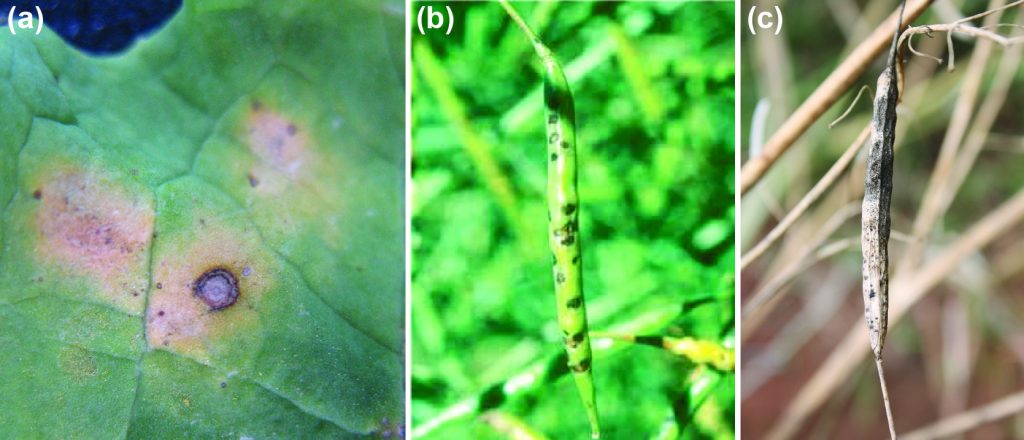Other common names: Black spot, Dark leaf spot, Alternaria blight
Alternaria is usually caused by the fungal pathogen Alternaria brassicae and occasionally by Alternaria brasicicola. The severity of the disease varies between years and locations depending on seasonal conditions. The disease is favoured by warm humid conditions during spring. Yield loss is unusual and is normally associated with the shattering of infected pods. If infected seed is retained for sowing in subsequent years, seedling blight may occur (refer to damping-off section).
What to Look For
Alternaria infects all growth stages of canola plants. However, as plants mature from mid flowering onwards they are more susceptible to infection. Alternaria symptoms can be found on all parts of the plant including leaves, stems and pods. Spots on leaves and pods have a concentric or target-like appearance and are brown, black or greyish white with a dark border.
Lesions on green leaves are often surrounded by a chlorotic (yellow) halo. Severe pod infections may cause seed to shrivel and the pods to prematurely ripen and shatter. Pod symptoms of alternaria are similar to those of blackleg and the two can be difficult to distinguish in the field.

Symptoms of alternaria on canola. (a) Alternaria lesions on the leaf (note target like rings). (b and c) Pod lesions that can lead to premature pod shattering. Photos: S. Marcroft
Disease Cycle
Alternaria spp. survive the intercropping period on infected canola stubble, on cruciferous weeds and to a lesser extent on seed. Seed infections can cause seedlings to rot (refer to damping-off section) resulting in a seedling blight that reduces plant establishment. Initial crop infections are caused by windblown spores. Spores remain intact on susceptible plants until moisture from dew or rain allows them to penetrate into the tissue and cause a lesion. These lesions produce more spores and infections can then be spread throughout the crop by either the wind or rain.
Mild, humid conditions favour disease development and the disease cycle will continue throughout the season under favourable conditions. Hot and dry conditions interrupt epidemics as the absence of moisture greatly reduces spore production. Major outbreaks are not common in
Australia as weather conditions are normally hot and dry throughout podding which is unfavourable for prolonged infection. However severe pod infection can occur in years when rainfall continues into late spring, especially when there is a wet harvest.
Management
- alternaria is very common in canola crops but is not usually severe enough to warrant control.
- in Australia, there are no registered fungicide seed treatments for Alternaria.
- in areas where alternaria is a problem, select paddocks isolated from last year’s canola stubble as alternaria spores are easily transported in wind and can spread into areas that have not had canola for several years.
Please note: This book is also available on AppleBooks


